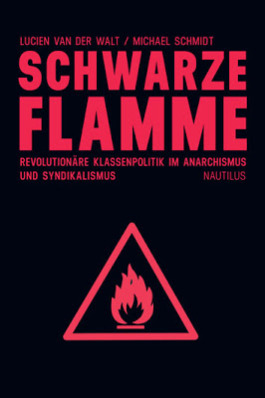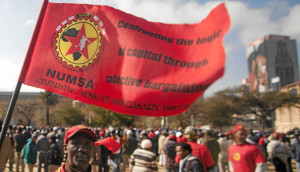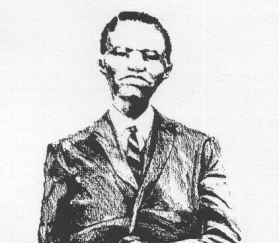Lucien van der Walt, 2013, “(Re)Constructing a Global Anarchist and Syndicalist Canon – a response to Robert Graham and Nathan Jun on ‘Black Flame‘,” ‘Anarchist Developments in Cultural Studies,’ special issue on ‘Blasting the Canon,’ No 1 (2013), pp. 193-203
 Online PDF mirrored here from here http://anarchist-developments.org/index.php/adcs/article/view/79/92
Online PDF mirrored here from here http://anarchist-developments.org/index.php/adcs/article/view/79/92
This article defends the argument that anarchism / syndicalism emerged in the 1860s, as a libertarian form of socialism, opposed to social and economic hierarchy/inequality, favouring international class struggle and revolution, from below, for a self-managed, socialist, stateless order; it defends the necessity using a truly global history and analysis, placing the colonial and postcolonial world, and a wide range of mass movements, centre-stage, in order to grasp the “canon” of texts/thinkers/theories that must be ‘regarded as authoritative for anarchist thought and practice or especially significant in the historical development of anarchism.’ It rejects claims that anarchism is a timeless “orientation” existing outside of contexts and classes, and demonstrates the methodological and analytical problems that arise from such approaches, including tautology, assertion and selective use of evidence.
Lucien van der Walt, 2013, “(Re)Constructing a Global Anarchist and Syndicalist Canon – a response to Robert Graham and Nathan Jun on ‘Black Flame‘,” ‘Anarchist Developments in Cultural Studies,’ special issue on ‘Blasting the Canon,’ No 1 (2013), pp. 193-203
Lucien van der Walt*
Robert Graham’s and Nathan Jun’s thought-provoking interventions in this special issue on ‘Blasting the Canon,’ regarding Michael Schmidt and my _Black Flame: The Revolutionary Class Politics of Anarchism and Syndicalism_ (2009), is welcomed. It is a pleasure to engage two thoughtful writers, and their considerations on the anarchist canon—i.e., the texts/thinkers/theories that (as Jun argues) should be ‘regarded as authoritative for anarchist thought and practice or especially significant in the historical development of anarchism.’
GRAHAM’S AND JUN’S CRITICISMS—AND MY CORE RESPONSE
_Black Flame_ made a wide range of arguments–about, for example, the social basis of anarchist peasant uprisings, the movement’s anti-colonial/anti-imperialist struggles, approaches to gender and unionism, struggle for the city etc. It has, of course, also spurred debates on anarchist (and syndicalist) theory, history and canon—such debate was one of its stated intentions (van der Walt and Schmidt 2009: 26-27).
The argument that is at issue with Graham and Jun is a fairly small part of _Black Flame_—the claim that anarchism (and its offshoot, syndicalism) is a distinctly modern phenomenon, born in the international socialist/ working class movement—specifically, the First International (1864-1877).
Here, in debates with Marxists and others, anarchism emerged as a distinct current, centred on the Alliance of Socialist Democracy: core members included Bakunin, Kropotkin and Malatesta. Anarchism was a libertarian form of socialism, opposed to social and economic hierarchy/inequality, favouring international class struggle and revolution, from below, for a self-managed, socialist, stateless order; syndicalism is one anarchist strategy (van der Walt and Schmidt 2009: 71, 170).
Graham objects, claiming that _Black Flame’s_ approach is ‘narrow’ and ‘extraordinary’ (by excluding certain trends), ‘circular’ in approach, contradictory (for supposedly insisting that anarchism be ‘internally coherent,’ while tolerating an incoherent ‘socialism’ encompassing Marxism and anarchism), and closed to‘significant departures or modifications’ or ‘refinement’ (thus, ‘dogma’).
Jun claims it is circular, with a ‘No True Scotsman’ fallacy (setting arbitrary, shifting standards for inclusion into ‘anarchism’). He rejects its (supposed) claim that anarchism is ‘whatever the mainstream’ of ‘historical anarchism’ accepted (since this might leave out other ‘anarchist’ views). He claims this is like asking a medieval European Catholic for a general survey of Christianity.
Both favour a vague (they say, ‘broad’) definition: for Graham, this means the ‘possibility of anarchist doctrines arising independently in different eras and circumstances,’ with anarchism having ‘different schools, currents and tendencies.’ Jun is more sweeping: ‘anarchism’ is not a ‘doctrine,’ but an ‘orientation’ ‘throughout human history,’ while not admitting this entails ‘mass excommunications.’
I suggest, however, that these are serious misrepresentations of the _Black Flame_methodology, claims and coverage—Schmidt and I provide a historically-based argument that _tracks_ the rise of anarchism (and syndicalism), _summarises_ its key claims, _traces_ its evolution and spread, _analyses_ its key debates and moments—this is a fairly standard social science approach, not an exercise in arbitrary boundary setting. And, rather than being ‘narrow,’ it uses a truly global history and analysis, placing the colonial and postcolonial world, and a wide range of mass movements, centre- stage.
Secondly, I demonstrate that Graham’s and Jun’s alternative approaches are far from satisfactory: both claims for multiple ‘anarchisms’ are simply assertions, resting on _a priori_ positions that lack a clear methodological rationale or empirical basis, and that are constructed in ways rendering any falsification impossible. Neither provides reasoned grounds, nor evidence, for the supposed superiority of their alternative definitions.
Both authors, in short, manifestly fail to apply to their own approaches the same standards of rigour they demand from _Black Flame_. I submit that a historical, as opposed to a speculative approach, is more justified, and more fruitful.
RESPONSE: A HISTORICAL AND SOCIOLOGICAL METHODOLOGY
Graham and Jun dispute dating anarchism to the 1860s.
It is a matter of record, however, that the anarchist movement appeared as something _new_ to its contemporaries, rivals, and adherents; with this appearance, anarchism _first_ became the topic of scholarly enquiry, police investigation, and media attention (Fleming 1979: 17–19). Even writers favouring exceedingly loose definitions of ‘anarchism’ concede that ‘anarchism’ did not previously exist as a ‘political force’ (see, for example, Joll 1964: 58, 82, 84; Woodcock 1975: 136, 155, 170)—as, so indeed, does Jun, with his allusion to ‘historical anarchism’ (is there a different kind?).
The very question of whether there were earlier or ‘different schools, currents and tendencies’ of anarchism (Graham), or an anarchist ‘orientation’ ‘throughout human history’ (Jun) could not even be _posed_ before this moment.
It is, then, anachronistic to represent this new, specifically, consciously ‘anarchist’ movement (and its syndicalist branch) as but one in a number of anarchist ‘schools’ ‘throughout history.’
It was, and is, one of several more-or-less _libertarian_ ‘currents,’ including socialist variants like _autonomia_ (van der Walt and Schmidt 2009: 71–71). But to conflate these very different approaches with anarchism is unnecessary.
It also requires gutting the ‘anarchist’ movement of its specificities, while forcing the others into a single ‘anarchist’ category. And to make the effort to include Stirner, Zerzan, etc. into ‘anarchism’ has little real justification (besides a sort of dogmatic convention), yet is analytically costly.
By contrast, _Black Flame_ consciously undertakes defining ‘anarchism’ (and thus, considering its ideology, history and canon) through a broad, global, representative overview of the history of this new worldwide historical and social phenomenon through examining a wide range of cases.
Building on the Age of Revolutions, located in the ‘capitalist world’ and the working class and socialism ‘it created’ (van der Walt and Schmidt 2009: 96), anarchism was ‘simultaneously and transnationally’ constituted by a radical network in North Africa, Latin America, and Europe (van der Walt and Hirsch 2010: liv). It then expanded globally, its first mass formations including Cuba, Mexico, Spain, and the United States.
By focusing on this movement, and taking a global view, _Black Flame_abstracts the core, shared features of its ideology, it’s often misunderstood relationship with syndicalism, unpacks its major debates, divisions and developments, and its core social features—for example, the class character of its urban mass base.
This historical and sociological approach forms the basis for the conclusion Graham so hotly rejects: there ‘is only one anarchist tradition, and it is rooted in the work of Bakunin and the Alliance’ (van der Walt and Schmidt 2009: 71).
To describe this methodology as ‘completely circular’ (Graham), or as entailing a ‘No True Scotsman’ fallacy, or ‘excommunications’ (Jun), is a complete caricature, a failure to take seriously the core analysis Schmidt and I developed.
_Contra_ Graham, moreover, _Black Flame_does not require that anarchism be reduced to ‘self-described anarchists’: it only requires _ideological and organisational lineage_. The IWW thus fits in the broad anarchist tradition; Stirner does not. It does not _require_ that anarchism be ‘internally coherent’ (Graham), but merely claims that it _was_; this was a description.
There is no contradiction between a focused, precise definition, and a rich, nuanced, and broad account; the bulk of Black Flame provides a detailed history of the anarchist/syn- dicalist tradition, past and present.
RESPONSE: ‘NARROW’—OR GOING GLOBAL?
Graham’s charge that _Black Flame_ has a ‘narrow’ approach is unconvincing.
_Black Flame_is perhaps the only truly global, non-Eurocentric,survey of the theory and history of anarchism (and syndicalism), covering 150 years, and the only thorough survey of the tradition’s internal debates, again with a global—not a ‘narrow’— view.
Indeed, it is _precisely_ this scope that makes _Black Flame_ peculiarly central to any serious debate on the meaning of ‘anarchism’ and its canon.
This is radically different to the narrowly North Atlantic framing that dominates the standard English-language surveys— due credit must be given to Joll, Woodcock, and Marshall for their pioneering works, but it cannot be denied they almost entirely ignored the world outside of (only parts of) Western Europe and North America. [1]
Compounding this profound imbalance, such works discuss at length obscure Western figures like Stirner, whose historical importance is trivial, and links to anarchism doubtful. This problem continues today, with marginal Americans like Rothbard, Zerzan, etc., constituting common fare in ‘standard’ surveys—whilst major figures like Liu, Flores Magón, J.C. Mechoso, Shin, Szabó, Thibedi, etc. are (at best) passing asides.
But with a worldwide view, trivialities in the West fade away
in the light shed by truly important moments elsewhere. It is, then, rather peculiar to present _Black Flame_as ‘narrow,’ because it has a global sense of perspective.
Yet Graham continues: _Black Flame_has a problematic focus on ‘the more narrow’ world of ‘class struggle anarchism.’
What exactly is ‘narrow’ about this world? It is, by any measure, far larger and more influential than any other contender for the ‘anarchist’ label; a focus on it is _necessary_, not ‘narrow.’
This is the anarchism of towering figures, from insurrectionists (who Jun incorrectly assumes are excluded from _Black Flame_) like Galleani, to mass anarchists and syndicalists like Bakunin, Chu, Durruti, Goldman, Gutarra, Kim Jwa-Jim, Kropotkin, Makhno, Malatesta, Ōsugi, Rocker, and every historically important anarchist/syndicalist formation, from the Argentinean FORA and _Voz de la Mujer_, to Spain’s CNT and Mujeres Libres, to the global IWW, South Africa’s ISL/IWA, the Hunan Workers’ Association, FAU/OPR-33, the Korean _Ůiyŏltan_, etc.
What ‘school’ of significance is lost by this focus? This is the force that activated revolutions in Spain, Ukraine, and Manchuria, and demonstrated anarchism was a means to change the world.
RESPONSE: ‘DOGMA’ OR LIVING TRADITION, CENTRAL TODAY?
Does _Black Flame’s_ focus somehow turn ‘anarchism from a living tradition into a historical relic or dogma’ (Graham)? No, since ‘class struggle anarchism’ (his term) has a rich, powerful history, and is _also_ a ‘living tradition’.
This is the tradition represented today by such key examples as the Spanish CGT and CNT, the Chilean FEL, Brazilian FARJ and Uruguayan FAU, the IWA/AIT, Egyptian LSM and other Africans, Anarkismo.net, the Greek rebels, and innumerable local groups and projects worldwide. Notions popularised by certain academic texts—that worker-peasant anarchism has been superseded or overwhelmed by a post-1945 ‘new anarchism’ (e.g., Woodcock, 1975)—are highly misleading, even for the West today.
Graham worries that a strict definition will mean that ‘significant departures or modifications’ will entail exclusion from ‘anarchist status.’ But _every_ definition implies exclusion. Example: Russian ‘anarchist’ Bill Shatov’s ‘modifications’ included, as Petrograd Bolshevik police chief in 1918, crushing anarchists (Bryant 1923). Must he perpetually retain ‘anarchist status’?
Graham notes that some figures in the anarchist tradition (like Landauer) drew on other ideas (like Tolstoy). _Black Flame’s_ point, however, is that what a tradition _shares_ constitutes its defining features, the parameters for ‘refinement.’ (And Landauer, Tolstoy aside, was an anarchist, who died for the Munich councils revolution.)
RESPONSE: ONE, TWO, THREE MANY “ANARCHISMS”?
Of course, there are probably libertarian elements in all cultures, religions and historical periods (and most modern political ideologies).
But are these all _anarchist_? Graham and Jun insist they are, and claim this approach has support from ‘notable members’ of ‘historical anarchism’ like Kropotkin and Rocker.
This latter claim is indeed true—but does not resolve the matter.
Is this not precisely the methodological error that Jun claims of _Black Flame_ : asking a medieval Catholic for a survey of Christianity? Further, if anarchism arises ‘independently in different eras and circumstances,’ or ‘throughout history,’ why should Kropotkin have decisive weight? But if Kropotkin does, then why should his movement’s politics not define the parameters of anarchism?
Yet Graham and Jun _must_ invoke Kropotkin and Rocker, since it would be obviously anachronistic (and futile) to consult the works of those outside Kropotkin’s tradition (e.g., Lao, Win stanley, Godwin, and Stirner) for opinions on the general history of ‘anarchism.’
Graham and Jun are also engaging here in a rather selective reading, skipping over Kropotkin’s and Rocker’s writings that make claims _identical_ to _Black Flame_ : anarchism as new, revolutionary, socialism (e.g., Kropotkin 1927: 46, 289–290; Rocker [1938]1989: 23–24, 34–35). It was, indeed, Kropotkin—and not _Black Flame_ , as Jun suggests—who termed Stirnerism ‘misanthropic bourgeois individualism,’ opposed to anarchism’s ‘communist sociability’ (van der Walt and Schmidt 2009: 47–48).
What Graham and Jun also miss is that Kropotkin and Rocker were increasingly involved in manufacturing, for the controversial, embattled, anarchist movement, a legitimating propaganda _mythology_. This centred on precisely the claim that ‘anarchism’ existed ‘throughout history’ that Jun favours.
This myth-making was only possible once anarchism had _emerged_ in the 1860s—it started around 40 years later. It is a claim to antiquity by a new movement, no more evidently true than equivalent nationalist myths. Both anarchist and nationalist myths have an obvious political function, but they are analytically misleading and often demonstrably false: Kropotkin’s work in this genre was marked by contradictory claims and rather dubious readings of past trends.[2]
While many are (rightly) sceptical of nationalist mythologies, anarchist mythology continues to have a firm grip. Yet rather than interrogate such claims, many activists and scholars compound the problem by grouping widely different libertarian (and not so libertarian) strands into ‘anarchism,’ sometimes by selecting an (arbitrary) group of writers (e.g., Eltzbacher’s ‘seven sages’ approach: [1900] 1960), sometimes by creating vast compendiums of anything vaguely libertarian (Marshall [2008] starts with prehistory).
But this sort of exercise requires anachronistic, selective readings of the past, and such exceedingly vague (and often shifting) definitions of ‘anarchism’ as to render the term meaningless. For example, bringing Stirner into the same category as Bakunin requires eliding great differences, effectively reducing anarchism to ‘negating the state’ (Eltzbacher [1900] 1960: 189, 191, 201).
Two major problems then arise.
First, the boundaries such an exercise requires are necessarily shaky. For example, if anarchists are those who merely ‘negate the state,’ they must include Marxist-Leninists seeking the state’s ‘withering away’ (e.g., Mao [1949] 1969: 411), and neo-liberals opposed to statism (e.g., Thatcher, 1996). Since neither trend appears in most surveys of anarchism (except Marshall 2008: xiii, 517–518, 560), their exclusion is arbitrary and/or a _de facto_ admission of the stated definition’s fallacy.
Either way, the loose definition is unjustifiable, lacking clear criteria for inclusion and exclusion.
RESPONSE: ON METHODOLOGY AND ALTERNATIVES
Secondly, the arbitrary nature of the loose approach to studying ‘anarchism’ is exposed. An approach that seeks to assimilate as much as possible to ‘anarchism’—presenting ‘anarchism’ not as a concrete historical phenomenon, but as multiple ‘doctrines arising independently’ (Graham) or an ‘orientation’ ‘throughout history’ (Jun)—_must_ start from a preset _definition_ of anarchism in such terms by the writer. This definition is not tested, but assumed true; it is freed from the possibility of falsification.
Or, it _must_ start from an arbitrary _selection_ of cases, from which the definition is developed (e.g., Eltzbacher [1900] 1960). The problem here is that the selection lacks justification besides anecdote, convention, or personal preference (see van der Walt and Schmidt 2009: 35). The basis for the category is thus itself unreasonable; its boundaries end up equally so.
When Graham insists that anarchism has many ‘schools,’ he fails to provide a reasoned basis for this assertion. Having insisted _Black Flame_ has a ‘completely circular’ methodology, Graham simply asserts his claim, and then finds data that fits. When the claim is disputed, he can invoke the data thus generated, as evidence to support the claim’s veracity, thereby presenting alternatives as ‘narrow’—a tautology.
Jun asserts, also without serious grounds, that ‘anarchism’ exists ‘throughout human history.’ Once this is taken as true, it is easy enough to find an anarchist ‘orientation’ everywhere. The problem is that the definition rests upon nothing solid. Jun’s story of the medieval Catholic’s limitations reveals his assumptions: anarchism self-evidently exists universally; disagreement is evidence of intolerant ‘excommunication’ or parochial ignorance.
But the basis for the superiority, even validity, of Jun’s definition is never initially established.
To return to Jun’s medieval Catholic: it is well-established that the Christian Church first appeared two thousand years ago, attracting police, public, and scholarly attention; also that Catholicism was one of its main branches. By contrast, it is hardly self-evident that ‘anarchism’ has existed ‘throughout history,’ or that the movement of Bakunin, Kropotkin, Kim, Makhno, Mechoso, Thibedi et al. was merely one isolated branch.
RESPONSE: THE MEANING OF A WORD
And what do Graham and Jun mean by ‘anarchism’? For Graham, a ‘doctrine’ wanting society ‘without government,’ or ‘formal structures of hierarchy, command, control and obedience’ (Graham 2005: xii–xiv). For Jun, a loose ‘orientation,’ fusing ‘radical antiauthoritarianism and radical egalitarianism,’ opposing ‘morally unjustifiable . . . authority and inequality,’ and ‘unnatural’ or ‘arbitrary’ inequality, coercion or domination.
These are rather different claims, and in neither case is their validity obvious. Why is either better than that of _Black Flame_ or one another? Is anarchism a ‘doctrine,’ several ‘doctrines,’ or an ‘orientation’? Opposed to hierarchy or inequality?
There is no way of really resolving these issues, since this is discussion of _a priori_ assertions. And these are also replete with ambiguities: Is _informal_ hierarchy acceptable to Graham’s anarchists, or ‘obedience’ to agreed norms or essential ‘control’? In Jun’s case: what of ‘morally’ _justifiable_ inequality, or the coercion and domination that is neither ‘arbitrary’ nor ‘unjustified,’ like the military actions of the 1936 Durruti Column?
And there is, again, the problem of arbitrary inclusion/ exclusion. Both Graham and Jun include in their ‘anarchist’ gallery, figures that demonstrably do not conform to either definitions, such as Stirner—who rejected any constraints on individual’s right to ‘take’ by ‘might’ whatever they wanted, regardless of ‘justice,’ ‘truth’ and ‘equality’ (Stirner [1844] 1907: 200, 339, 421, 472).
And here we come full circle on the problems of vague definitions.
RESPONSE: SOME NOTES ON ARGUMENTS BY LABELLING
Graham claims that insisting that anarchism has definite historical referents is ‘analogous to reducing Marxism to canonical figures and texts’; he speaks of _Black Flame_ as promoting ‘dogma,’ while Jun invokes spectres of ‘mass excommunications.’
Such points are rather unpleasantly framed, tainting _Black Flame_ with a scent of heresy—argument-by-labelling that does not take us anywhere. Graham’s own anthology work, after all, is a definite attempt to construct a canon of ‘figures and texts’; Jun, too, admits that all political traditions entail some exclusions. If this means ‘dogma’ or ‘excommunication,’ the charge must apply to Graham and Jun as well.
CONCLUSION: A CLASS STRUGGLE, GLOBAL CANON—AND WHY
The issue is not, then, _whether_ anarchism has definite ‘canonical figures and texts,’ but _which_ merit inclusion. Vague claims about the nature of anarchism, developed through weak methodologies, cannot provide an adequate basis, since they entail deeply flawed definitions.
For its part, _Black Flame’s_ approach suggests the need to throw overboard spurious canons like the ‘seven sages,’ and to instead develop a historically-based, global canon, an accurate reflection of anarchism (and syndicalism) as a historical and contemporary current.
This must necessarily include Bakunin and Kropotkin, and while Stirner, Tolstoy and Thatcher have no justified place, figures like Goldman, He Zhen, Infantes, Landauer, Liu, Flores Magón, Makhno, Mechoso, Osugi, Rouco Buela, Shin, Szabó, and Thibedi must surely be serious candidates for canonical status.
AUTHOR: Lucien van der Walt works at Rhodes University, South Africa. He is the author (with Michael Schmidt) of _Black Flame: The Revolutionary Class Politics of Anarchism and Syndicalism_ (2009), and the editor (with Steve Hirsch) of _Anarchism and Syndicalism in the Colonial and Postcolonial World, 1880-1940_ (2010). He has published widely on labour and left history and theory, and political economy. Involved in union education and working class movements.
NOTES:
[1] Woodcock (1975) gave Latin America 3 pages, ignoring Africa, Asia, Australasia, and most of Eastern Europe; Joll (1964) gave the rest 9 pages; Marshall (1998) gave 2 of 41 chapters (33 of 706 pages) to Asia and Latin America.
[2 ] For example, his 1905 ‘Anarchism’ (in Kropotkin 1927) deploys quite contradictory definitions: anarchism as ancient philosophy (287–288), as ‘first formulated’ in the 1790s (289–290), as new, 19th-century, revolutionary socialism (285–287), as a scheme for peaceful reform (290–291) etc.
REFERENCES
Bryant, L. 1923. Mirrors of Moscow. New York: Thomas Seltzer.
Eltzbacher, P. [1900]1960. Anarchism. London: Freedom.
Fleming, M. 1979. The Anarchist Way to Socialism: Elisée Reclus and Nineteenth-Century European Anarchism. Lanham, MD: Croom Helm/Rowman Littlefield.
Graham, R., ed. 2005. Anarchism: A Documentary History of Libertarian Ideas, Vol. 1: From Anarchy to Anarchism, 300 CE to 1939. Montréal: Black Rose.
Joll, J. 1964. The Anarchists. London: Methuen and Co.
Kropotkin, P. 1927. Kropotkin’s Revolutionary Pamphlets. New York: Dover.
Mao Zedong. [1949] 1971. “On the People’s Democratic Dictatorship.” Selected Readings from the Works of Mao Tsetung. Peking: Foreign Languages Press.
Marshall, P. 1998. Demanding the Impossible: A History of Anarchism. New York: Harper Perennial.
Rocker, R. [1938] 1989. Anarcho-syndicalism. London: Pluto Press.
Stirner, M. [1844] 1907. The Ego and His Own. New York: B.R. Tucker.
Thatcher, M. 1996. “Speech at Poznan Academy of Economics,” July 4: http://www.margaretthatcher.org/document/108362.
Van der Walt, L. and S.J. Hirsch. 2010. “Rethinking Anarchism and Syndicalism: The Colonial and Post-colonial Experience, 1870–1940,” in Lucien van der Walt and S.J. Hirsch, eds., Anarchism and Syndicalism in the Colonial and Postcolonial World, 1870-1940. Leiden: Brill.
Van der Walt, L. and M. Schmidt. 2009. Black Flame: The Revolutionary Class Politics of Anarchism and Syndicalism, Vol. 1.: Counter-Power. Oakland: AK Press.
Woodcock, G. 1975. Anarchism, rev. edn. London: Penguin.

 © privat
© privat Michael Schmidt ist erfahrender Reporter und investigativer Journalist, dessen Reportagen ihn nach Chiapas, Guatemala, die DR Kongo, Mosambik, Ruanda, Darfur, in den Libanon und anderswohin führten. Der frühere gewerkschaftliche Vertrauensmann und Gründer der Professional Journalists’ Association of South Africa nahm 2011 am Clive Menell Media Fellowship der Duke University teil. Schmidt ist Autor der Cartographie de l’anarchisme révolutionnaire (2012) und leitet gegenwärtig das Institute for the Advancement of Journalism im südafrikanischen Johannesburg. Weiterhin schreibt er sowohl für etablierte als auch für alternative Medien.
Michael Schmidt ist erfahrender Reporter und investigativer Journalist, dessen Reportagen ihn nach Chiapas, Guatemala, die DR Kongo, Mosambik, Ruanda, Darfur, in den Libanon und anderswohin führten. Der frühere gewerkschaftliche Vertrauensmann und Gründer der Professional Journalists’ Association of South Africa nahm 2011 am Clive Menell Media Fellowship der Duke University teil. Schmidt ist Autor der Cartographie de l’anarchisme révolutionnaire (2012) und leitet gegenwärtig das Institute for the Advancement of Journalism im südafrikanischen Johannesburg. Weiterhin schreibt er sowohl für etablierte als auch für alternative Medien.
 PDF is online
PDF is online  PDF is online
PDF is online 
